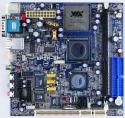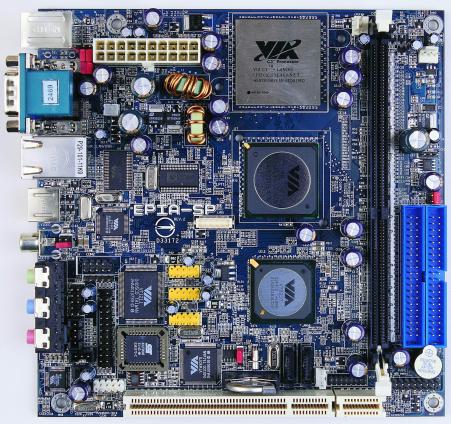Next-gen VIA mobo touts speed, security, MPEG-4
May 27, 2004 — by LinuxDevices Staff — from the LinuxDevices Archive — 2 views VIA will preview its next-generation mini-ITX board for the consumer electronics market at next week's Computex 2004 in Taipei. The EPIA SP features a new graphics and memory controller hub (GMCH) supporting faster front-side bus (FSB), memory, and southbridge interconnect speeds. It also features a C3 processor clocked at 1.3GHz, integrated PadLock Hardware Security Suite, and MPEG-4 acceleration.
VIA will preview its next-generation mini-ITX board for the consumer electronics market at next week's Computex 2004 in Taipei. The EPIA SP features a new graphics and memory controller hub (GMCH) supporting faster front-side bus (FSB), memory, and southbridge interconnect speeds. It also features a C3 processor clocked at 1.3GHz, integrated PadLock Hardware Security Suite, and MPEG-4 acceleration.
The SP is the first in VIA's EPIA line of Mini-ITX mainboards to feature the CN400 GMCH. The CN400 replaces the CLE266 GMCH, adding support for 200MHz front-side bus speeds, a 1GB/s southbridge interconnect, and the ability to address up to 8GB of DDR400/333/266 RAM. The older CLE266 supported FSB speeds of only 133MHz, DDR266 RAM, and a 266MB/s southbridge interconnect.
Additionally, the CN400 supports MPEG-4 acceleration in hardware.

VIA's new Epia SP features a new Northbridge chip that supports faster FSB, memory, and interconnect speeds
(Click to enlarge)
The VIA EPIA SP uses the VT8237 South Bridge, which interfaces with USB 2.0, Firewire, native Serial-ATA, and V-RAID, with support for RAID 0, RAID 1, and RAID+1 arrays. It also interfaces with the onboard 6-channel surround sound VIA Vinyl Audio chip.
The new board uses a 1.3GHz version of the C5P-core C3 chip introduced in VIA's current top-end board, the MII 12000. The latest C3 processor features an integrated AES encryption engine and two random number generators that work with the PadLock ACE software to perform user authentication, DRM, or other security operations in the background, with no impact on digital video playback performance, VIA says.
The new VIA board uses a UniChrome Pro IGP graphics core from VIA graphics chip division S3. The chip includes a “Chromotion Video Display Engine” with advanced video rendering functions such as “Video De-blocking” and “Adaptive De-interlacing,” which add to the user's “Hi-Def visual experience,” according to VIA. The board supports displays including all HDTV formats, and NTSC or PAL TVs.
“The additional MPEG-4 and AES encryption functionality provides our customers with a significant competitive edge for compact x86 consumer electronics devices,”
said Steven S. Lee, Head of the VIA Embedded Platform Division.
This article was originally published on LinuxDevices.com and has been donated to the open source community by QuinStreet Inc. Please visit LinuxToday.com for up-to-date news and articles about Linux and open source.